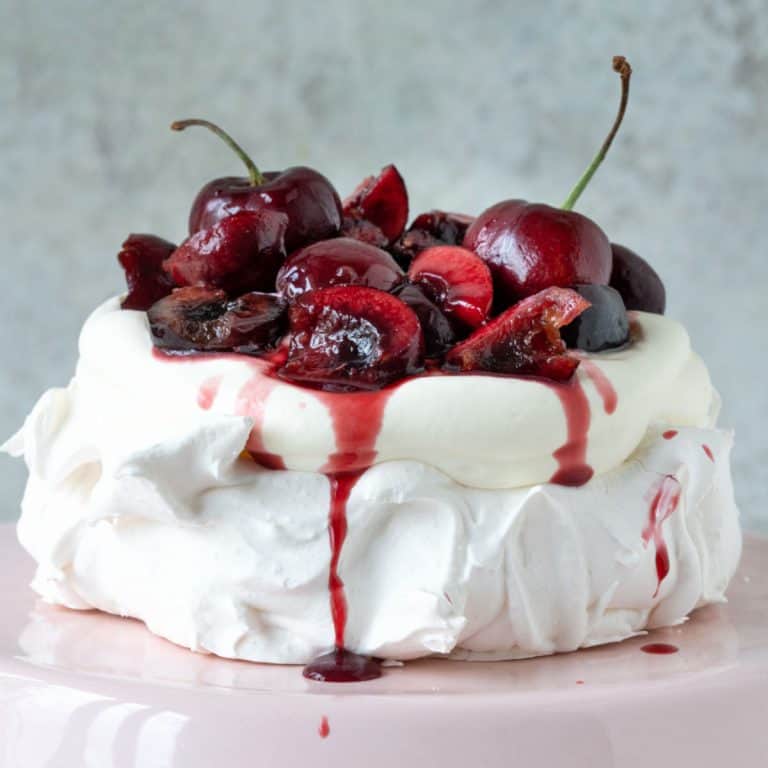Ingredients
Units
- 4 fresh egg whites (160g) at room temperature
- Pinch of salt
- 250g (1 1/4 cups) white superfine sugar
- 2 teaspoons cornstarch
- 1 teaspoon white vinegar
Whipped cream topping:
- 1 cup heavy cream
- 2 tablespoons powdered sugar
- 1 1/2 cups fresh cherries, pitted (a few whole for decoration)
Lemon berry topping:
- 1 recipe homemade lemon curd (or use store-bought)
- 1 1/2 cups fresh mixed berries
Instructions
- Turn on the oven to 350°F/180°C (medium, then we will lower it).
- Line a baking sheet with parchment paper.
For the meringue mixture:
- Beat the egg whites with the salt in the bowl of a stand mixer. You can use an electric mixer, but it’ll take longer to properly beat the whites.
- Start beating at low speed, then increase to medium speed, and when the egg whites start to form a peak, increase to high speed and add the sugar gradually. Don’t add it all at once.
- Beat until firm peaks form; that means when you lift the beater (turn off the mixer first), the peak tip stands straight up and doesn’t tilt.
- If you check once or twice during the beating, you’ll see that you'll go from soft peaks to stiffer peaks, with the tip holding a little firmer every time. That means the whipping is going well.
- Turn off the mixer, remove the whisk attachment and add the sifted cornstarch and vinegar. With a rubber spatula, gently mix to incorporate, deflating the meringue mixture as little as possible.
- Your meringue is ready to be baked.
Baking the pavlova:
- You can use a piping bag with a smooth, large tip or two spoons for a more rustic-looking pavlova.
- Make circles on the prepared baking sheet, several small ones (for individual mini pavlovas) or one large one. It can be round, square or rectangular.
- Spoon a mound of meringue in the center of the shape you want to make and spread it carefully. Add more if you want a taller pavlova. Reinforce the edges if you want higher sides and a lower center (to encase the filling). Do it slowly and carefully so you can course-correct it.
- Carefully transfer the sheet to the preheated oven and immediately lower the temperature to 230°F/110°C, very low.
- Bake until the edges are firm and dry, but the center is barely soft to the touch. And, if handled gently, it begins to peel off the paper on its own when you lift it.
- The baking time depends on the size of the pavlova, the oven and the humidity of the day, but it takes 1 hour at least for a medium pav. If it's your first time, it’ll probably take a few tries to get the desired shapes and baking times and create a perfect pavlova.
- Turn off the oven and let it cool completely. I make it at night and leave until the next day. They might slightly crack as they cool, and that is normal.
Assembling the pavlova:
- Transfer the meringue disk to the serving plate or platter right before serving.
- Add the topping right before serving.
- Top with whipped cream or lemon curd and then with fresh berries.
- We love cream with fresh cherries or strawberries and lemon curd with mixed berries or raspberries. See Notes below.
Notes
- Organization: read the recipe first and ensure you have ingredients at the correct temperature, equipment, and enough workspace. This will make the process so much easier.
- Baking time: consider that all ovens and pans are different, even if they look similar. The baking time in my recipes is as accurate as it can be, but it might take you more or less time. You can use a thermometer (like the OXO oven thermometer) to check that your oven is at the right temperature. I recommend you keep track of how your oven works and what tiny details you might need to adjust.
- Fresh eggs are recommended for a pavlova for stability and volume. They are firmer and more stable, which makes it easier to whip them into stiff peaks. They can hold more air and create greater volume when whipped and are less likely to deflate or lose their volume during the whipping and baking process, resulting in a more successful pavlova.
- Lemon juice: use an equal amount of juice as the amount of vinegar called for in the recipe.
- Toppings: there is a long list of topping combinations that work to transform a pavlova into your perfect dessert. Use passion fruit curd with fresh fruit, chocolate whipped cream with chocolate sauce and caramel, pastry cream and fresh fruit, or whipped cream with lemon curd and berries. Find your favorite and make your signature pavlova dessert.
- Mini pavlova recipe: make small nests with this recipe. It yields about 6.
- Prep Time: 20 minutes
- Cook Time: 1 hour
- Category: Desserts
- Method: Baking
- Cuisine: International
